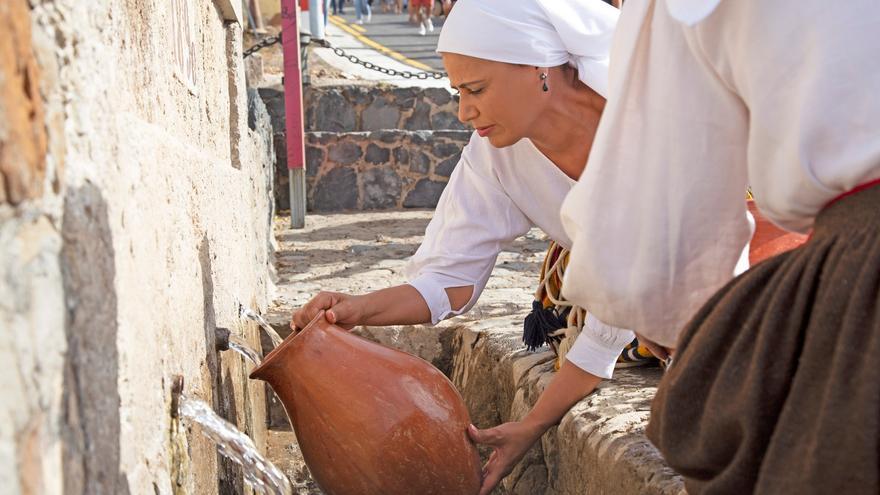
The Water Route returned to fulfill this Sunday, March 26, its scenic recreation function of a part of the history of adejeof their customs, of entertainment for neighbors, visitors and tourists with theater, music, songs and traditional dances. That was the germ with which this project of the Group of the Municipal School of Folklore launched this initiative: to energize the center of the southern town for a few hours with the guiding thread of one of its most precious assetsboth in the aboriginal era as in the centuries after the conquest. Water was a key element of survival, but also a fundamental piece in the colonization and economic development of this southern part of the island.
But, almost unintentionally, the activity of those who start this initiative it is an experience to discover the value of some elements of historical heritage to which the vast majority of citizens hardly pay attention, to the extent that they are not part of their daily life. Several of them have more than 400 years of history..
In front of almost a hundred spectators, some fifty people recreated scenes from the past linked to the Barranco del Infierno, Los Molinos street and the Casa Fuerte. In this edition, part of the usual route through the streets of the town was combined with the theatrical and musical representation inside the emblematic fortified hacienda founded by Pedro de Ponte several decades after the conquest of Tenerife.
Esther Perez Urbano, one of the founders of the organizing group, was in charge of relating the values of each symbol of the Route until the arrival at the Casa Fuerte. From that moment, as she has done for almost 35 years, she joined the theater and the dance group. And, once again, another of the founders of the Folklore School Group, Ana Oneida Borges he was in charge of introducing the public into history with his story full of passion.
The starting point was in the square at the entrance to the Barranco del Infierno. In the surroundings there are actors and extras who recreate jobs related to the use of the natural environment. The first relevant reference was the Molino de Arriba, a unique example in the Canary Islands, as explained by Pérez Urbano and Borges. It is a piece of aceña, that is, it has a wheel placed vertically on the ground and that was driven by the force of water, which fell from a higher plane and that allowed the necessary movement in the stones to grind the grain. . This patrimonial element is from the 16th century, as recorded in the archives on the assets of the Casa Fuerte.
Los Chorros de Arriba were the first “infrastructure” used by the population to supply themselves with water for domestic use. The creation of this resource is also located more than four hundred years ago. In addition, there was a memory for the now-defunct laundry rooms on the site that they occupied since 1936.
The descent down Calle Los Molinos had its next stop at Molino de Abajo, with a rodezno system, much more common on the islands and easier to install, with a horizontal wheel under a building, which part of the flow reached. of the ravine water.
Another of the scenes took place in the Abrevadero, also from the 16th century and which in the last historical stage was known as The donkey’s tank. Throughout history this piece has undergone some reforms, which have allowed its conservation until today.
After the essential reference to the operation of the sugar mill in the Casa Fuerte, attendees were invited to go inside the old hacienda. In one of the patios there were moments to evoke the life of the slaves used by several generations of the Ponte family and their descendants to work in different areas of their extensive properties. The songs of the washerwomen and their piques of love, the planting of cereals and the collection of sugar cane, the work of the water carriers or the figure of the emigrant were also part of the recreation. And the final scene was the symbolic bath of a newborn child.
The activity of the Water Route began in 2016. The then Councilor for Tourism, Ermitas Moreira, asked the Adeje Folklore School Group the possibility of developing some recreational activity in the old town. And from this group the possibility of centering a show related to the historical use of water was proposed. The proposal was well received, to the extent that it was to be developed close to International Water Day. Esther Pérez Urbano commented that, thanks to water, there has been an economic boost since the 16th century, but this, in turn, also brought social and religious development, thanks to which today the town has its historical-artistic heritage.
The pandemic prevented the act from taking place in 2020 and in the following year’s edition it was decided to record an audiovisual in the Barranco del Infierno and in the Casa Fuerte with different scenes. Already last year the staging was carried out, in an integral way, within the fortified hacienda.
















